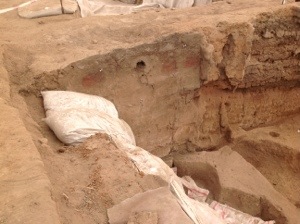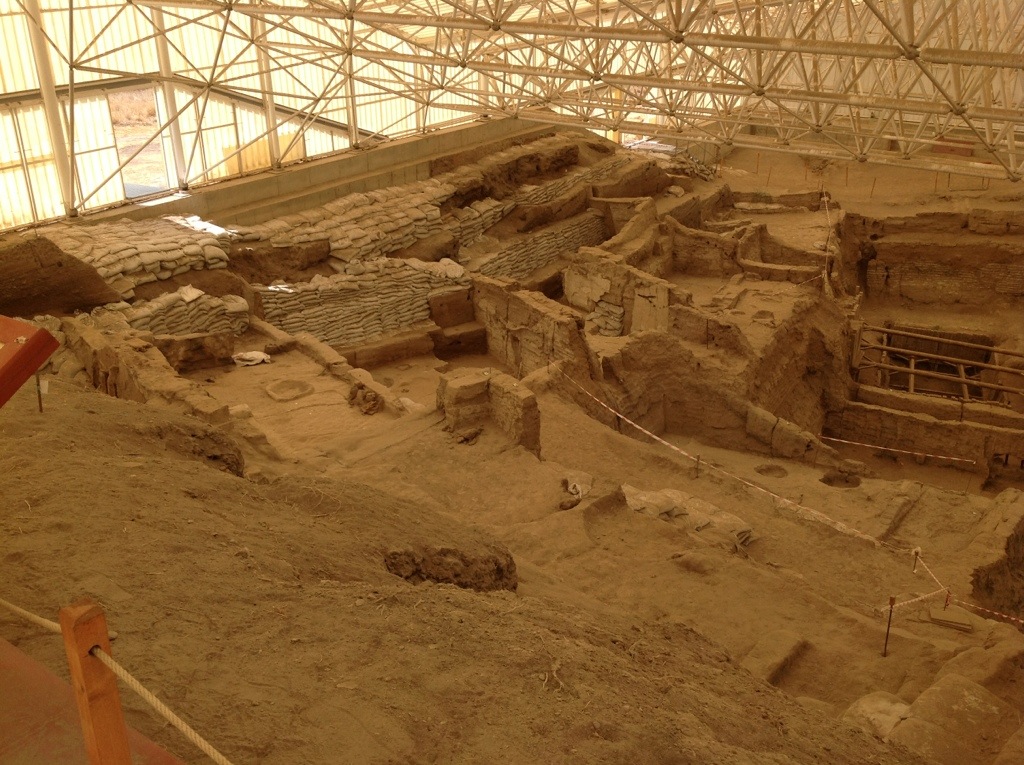Sunday, September 22, 2013
or Someday, ~9013 BC
Catalhuyuk, Turkey
Outside of Konya is a Neolithic settlement that is perhaps the oldest and earliest found to date of its kind. It is one of those places that is necessitating reevaluating what we think was our cultural history. This place is called Catalhuyuk.
I planned to go there since at this point going to Gobekli Tepe outside of Urfa is considered too dangerous because of its proximity to the Syrian border and current events. Gobekli Tepe is even older than Catalhuyuk, but was clearly a ceremonial location only with no settlement nearby. Catalhuyuk was a settlement, a community, perhaps with as many as 8000 inhabitants at its peak.
I had the incredible good fortune to serendipitously meet at breakfast a woman who was Australian, i.e. spoke English, is familiar with Turkey and knows some Turkish, wanted to go out to Catalhuyuk with me, and the piece de resistance, was an archeologist! Plus, the owner of the hotel was interested to go with us and provide a ride, which allowed us to not have to figure out a circuitous and expensive route with busses and taxis. So hotel owner Mehmet commandeered his best friend with car David, and took Elizabeth and me out to the site.
On our ride through the plain of commercial agriculture, Elizabeth pointed to a low mound to the right and then one to the left, and said, “See those mounds? Those were the ancient settlements.”
“Oh, you mean that they lived on top of those mounds?” I replied.
“No, those were the settlements. The communities started building on flat land, and when their houses fell, they would flatten the remains and build on top. So eventually it built up over many many years into mounds.”
When we got out to Catalhuyuk, we were confronted by a huge mound. The unusual story of its discovery by an archeologist in the 1800s was that he found Neolithic evidence at the bottom of the mound, and then found Neolithic also at the top, which meant that this location had been occupied in prehistory for a very long time.
Elizabeth pointed out that this whole location was about living together. There are no finds yet of a separate ceremonial building, or even of something like a communal gathering hall. It is entirely made of small rooms that are living quarters, entered through holes in the roofs. All these spaces are adjacent to each other, with no windows or doors. The communal space was the rooftops. This was the street and gathering place.
She pointed out that even though there was no “church”, so to speak, there was clearly a spiritual understanding. What most impressed me was the custom of burying the dead under the beds of the inhabitants. They knew something about the ancestors and the possibility of connecting through dreamtime. Some of these graves show evidence of such love. For instance, there was one of a woman tightly embracing a skull of a man which had been carefully decorated. And one of a baby with bracelets on its wrists and ankles.

There were paintings and sculptures on the walls, most of which have been stripped and moved to museums (next trip I visit Ankora!). A very few are still visible, such as handprints on one wall and some geometric decor on another. There was much painting and sculpture of aurochs, now removed. Interesting to me that I would have gotten a recent reference to aurochs through last year’s film “Beasts of the Southern Wild.” From one primal existence to another.
My impression is of a culture that was not separate from the land. They were perhaps the very first to domesticate grains and animals. It was pointed out to me that they did not choose domestication over hunting and gathering, but rather used everything that worked. In fact, even this style of building is still used today, except that now they have doors and windows.
I see a contrast with Greece, where it seemed that the first culture was imported full blown with the gods and goddesses of the archaic age. There is little evidence of the Neolithic period there, at least where I was taken. I did not realize until this morning that this missed step may be part of the spiritual divide from earth mysteries that I was intuiting. The people of Turkey have a little more of this gut connection, in my perception, although still buried unconsciously. (I caution myself to not make too many generalizations like this. People are individual rays of divine perception, with magnificently unique trajectories of experience. And yet as a culture, sometimes some broad brush strokes can point to a fuzzy truth.)
This visit to Catalhuyuk has left a deep impression in me. I feel a connection here. I feel an earth-based, peaceful community, living linked with respect for all the elements and ancestors. The dig at the site has only revealed perhaps 15 percent of the settlement. There is one spot where they intentionally dug down to bedrock, to see just how old this settlement might be. It is very far down.
Deep time is stacked together, all the way from bottom to top.
![]()


